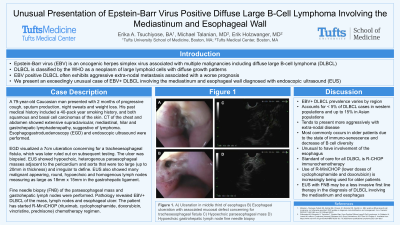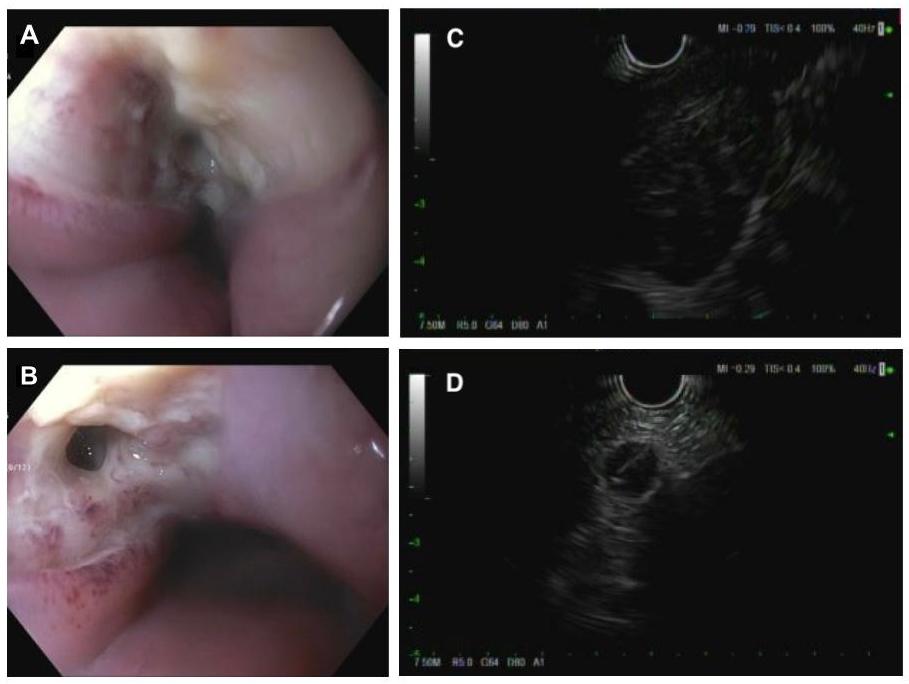Tuesday Poster Session
Category: Interventional Endoscopy
P4542 - Unusual Presentation of Epstein-Barr Virus Positive Diffuse Large B-Cell Lymphoma Involving the Mediastinum and Esophageal Wall
Tuesday, October 29, 2024
10:30 AM - 4:00 PM ET
Location: Exhibit Hall E

Has Audio

Erika A. Tsuchiyose, BA
Tufts University School of Medicine
Boston, MA
Presenting Author(s)
Erika A. Tsuchiyose, BA1, Michael Talanian, MD2, Erik Holzwanger, MD2
1Tufts University School of Medicine, Boston, MA; 2Tufts Medical Center, Boston, MA
Introduction: Epstein-Barr virus (EBV) is an oncogenic herpes simplex virus associated with multiple malignancies including diffuse large B-cell lymphoma (DLBCL) which is classified by the WHO as a neoplasm of large lymphoid cells with diffuse growth patterns. EBV positive DLBCL often exhibits aggressive extra-nodal metastasis associated with a worse prognosis. We present an exceedingly unusual case of EBV+ DLBCL involving the mediastinum and esophageal wall diagnosed with endoscopic ultrasound (EUS).
Case Description/Methods: A 79-year-old Caucasian man presented with 2 months of progressive cough, sputum production, night sweats and weight loss. His past medical history was notable for hypertension, hyperlipidemia, a 40-pack year smoking history, and both squamous and basal cell carcinomas of the skin. CT of the chest and abdomen showed extensive supraclavicular, mediastinal, hilar and gastrohepatic lymphadenopathy, suggestive of lymphoma. Esophagogastroduodenoscopy (EGD) and endoscopic ultrasound were performed. EGD visualized a 7cm ulceration concerning for a tracheoesophageal fistula, which was later ruled out on subsequent testing. The ulcer was biopsied. EUS showed hypoechoic, heterogenous paraesophageal masses adjacent to the pericardium and aorta that were too large (up to 20mm in thickness) and irregular to define. EUS also showed many malignant appearing, round, hypoechoic and homogenous lymph nodes measuring as large as 18mm x 15mm in the gastrohepatic ligament. Fine needle biopsy (FNB) of the paraesophageal mass and gastrohepatic lymph nodes were performed. Pathology revealed EBV+ DLBCL of the mass, lymph nodes and esophageal ulcer. The patient has started R-MiniCHOP (rituximab, cyclophosphamide, doxorubicin, vincristine, prednisone) chemotherapy regimen.
Discussion: EBV+ DLBCL prevalence varies by region, accounting for < 5% of DLBCL cases in western populations and up to 15% in Asian populations. EBV+ DLBCL tends to present as a more aggressive disease with extra-nodal disease and most commonly occurs in older patients due to the state of immuno-senescence and decrease of B cell diversity. It is unusual to have involvement of the esophagus with this disease. The standard of care for all DLBCL is R-CHOP immunochemotherapy and the use of R-MiniCHOP (lower doses of cyclophosphamide and doxorubicin) is increasingly being used for older patients. EUS with FNB may be a less invasive first line therapy in the diagnosis of DLBCL involving the mediastinum and esophagus.

Disclosures:
Erika A. Tsuchiyose, BA1, Michael Talanian, MD2, Erik Holzwanger, MD2. P4542 - Unusual Presentation of Epstein-Barr Virus Positive Diffuse Large B-Cell Lymphoma Involving the Mediastinum and Esophageal Wall, ACG 2024 Annual Scientific Meeting Abstracts. Philadelphia, PA: American College of Gastroenterology.
1Tufts University School of Medicine, Boston, MA; 2Tufts Medical Center, Boston, MA
Introduction: Epstein-Barr virus (EBV) is an oncogenic herpes simplex virus associated with multiple malignancies including diffuse large B-cell lymphoma (DLBCL) which is classified by the WHO as a neoplasm of large lymphoid cells with diffuse growth patterns. EBV positive DLBCL often exhibits aggressive extra-nodal metastasis associated with a worse prognosis. We present an exceedingly unusual case of EBV+ DLBCL involving the mediastinum and esophageal wall diagnosed with endoscopic ultrasound (EUS).
Case Description/Methods: A 79-year-old Caucasian man presented with 2 months of progressive cough, sputum production, night sweats and weight loss. His past medical history was notable for hypertension, hyperlipidemia, a 40-pack year smoking history, and both squamous and basal cell carcinomas of the skin. CT of the chest and abdomen showed extensive supraclavicular, mediastinal, hilar and gastrohepatic lymphadenopathy, suggestive of lymphoma. Esophagogastroduodenoscopy (EGD) and endoscopic ultrasound were performed. EGD visualized a 7cm ulceration concerning for a tracheoesophageal fistula, which was later ruled out on subsequent testing. The ulcer was biopsied. EUS showed hypoechoic, heterogenous paraesophageal masses adjacent to the pericardium and aorta that were too large (up to 20mm in thickness) and irregular to define. EUS also showed many malignant appearing, round, hypoechoic and homogenous lymph nodes measuring as large as 18mm x 15mm in the gastrohepatic ligament. Fine needle biopsy (FNB) of the paraesophageal mass and gastrohepatic lymph nodes were performed. Pathology revealed EBV+ DLBCL of the mass, lymph nodes and esophageal ulcer. The patient has started R-MiniCHOP (rituximab, cyclophosphamide, doxorubicin, vincristine, prednisone) chemotherapy regimen.
Discussion: EBV+ DLBCL prevalence varies by region, accounting for < 5% of DLBCL cases in western populations and up to 15% in Asian populations. EBV+ DLBCL tends to present as a more aggressive disease with extra-nodal disease and most commonly occurs in older patients due to the state of immuno-senescence and decrease of B cell diversity. It is unusual to have involvement of the esophagus with this disease. The standard of care for all DLBCL is R-CHOP immunochemotherapy and the use of R-MiniCHOP (lower doses of cyclophosphamide and doxorubicin) is increasingly being used for older patients. EUS with FNB may be a less invasive first line therapy in the diagnosis of DLBCL involving the mediastinum and esophagus.

Figure: Figure 1. A) Ulceration in middle third of esophagus B) Esophageal ulceration with associated mucosal defect concerning for tracheoesophageal fistula C) Hypoechoic paraesophageal mass D) Hypoechoic gastrohepatic lymph node fine needle biopsy
Disclosures:
Erika Tsuchiyose indicated no relevant financial relationships.
Michael Talanian indicated no relevant financial relationships.
Erik Holzwanger: Boston Scientific – Consultant.
Erika A. Tsuchiyose, BA1, Michael Talanian, MD2, Erik Holzwanger, MD2. P4542 - Unusual Presentation of Epstein-Barr Virus Positive Diffuse Large B-Cell Lymphoma Involving the Mediastinum and Esophageal Wall, ACG 2024 Annual Scientific Meeting Abstracts. Philadelphia, PA: American College of Gastroenterology.
